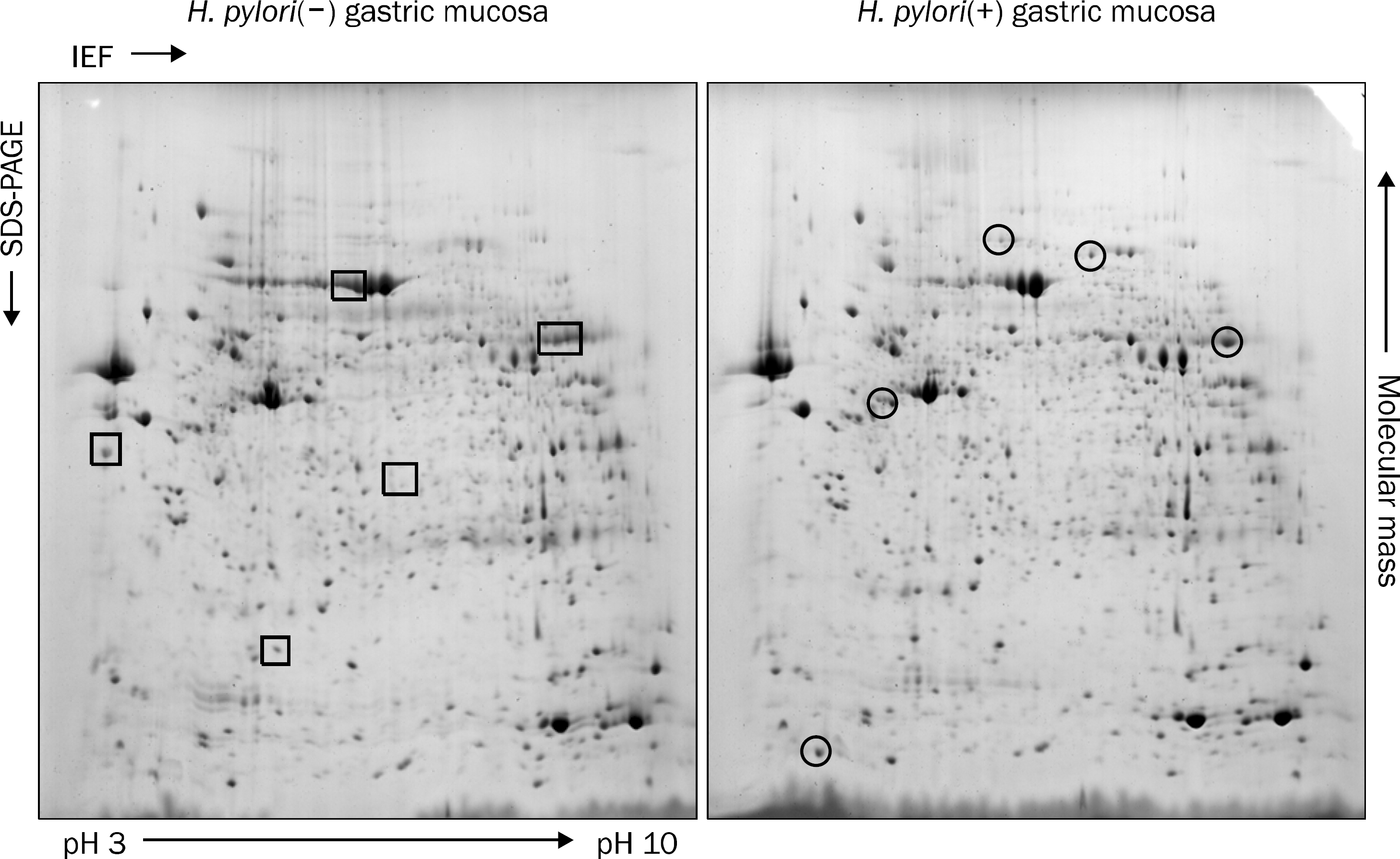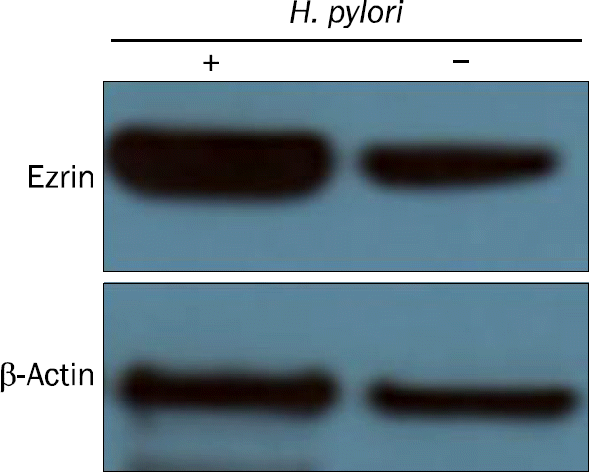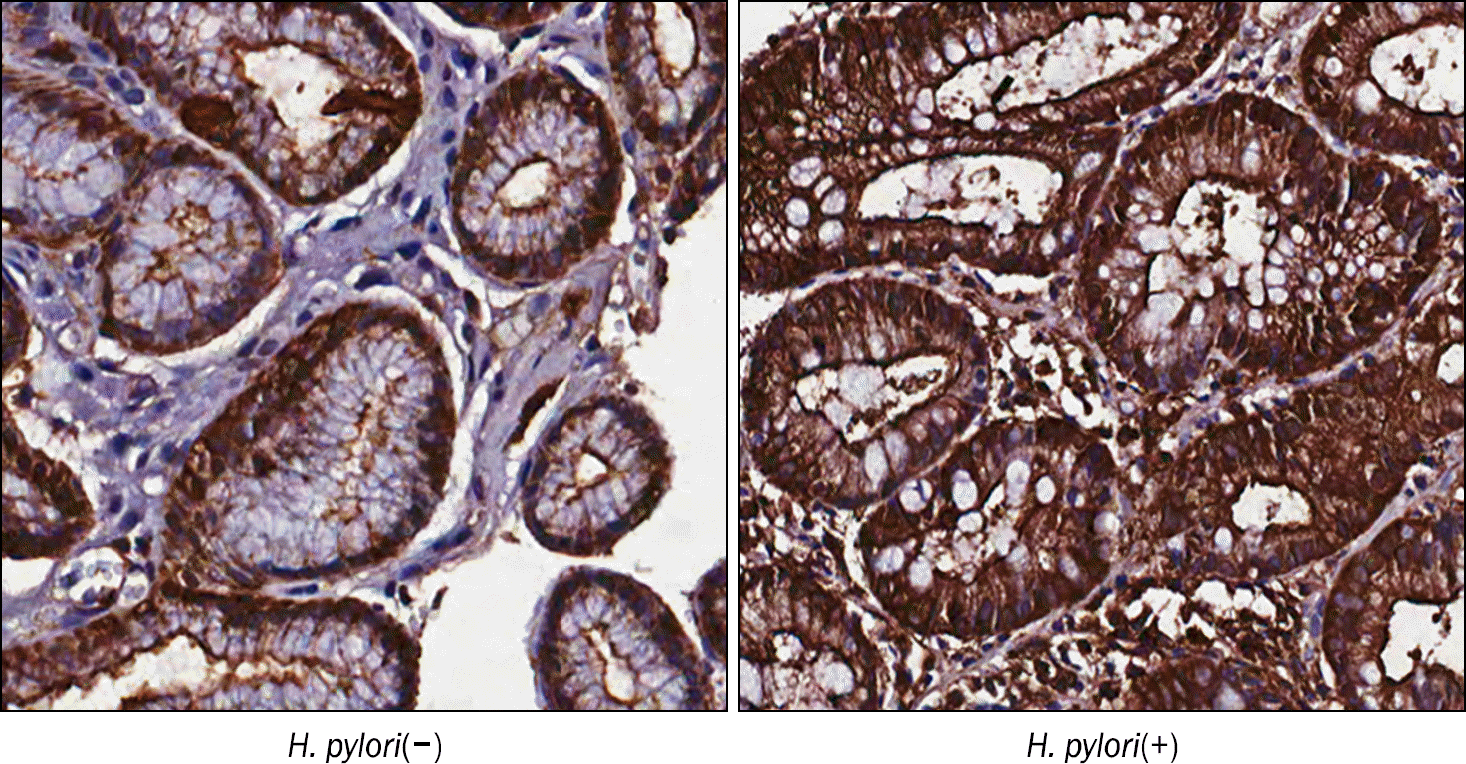Abstract
Background/Aims
Helicobacter pylori infection is linked to the development of gastric cancer. H. pylori-associated gastric inflammation is considered to be the first important step in the histogenesis of such neoplasia. However, studies that compare proteome of gastric mucosa infected with or without H. pylori are lacking.
Methods
We employed proteomics analysis on the endoscopic biopsy specimens of gastric mucosa obtained from two groups (30 cases): healthy subjects without H. pylori infection (15 cases), and gastritis patients with H. pylori infection (15 cases). The pooled proteins obtained from gastric mucosa infected with or without H. pylori were separated by two-dimensional gel electrophoresis and analyzed by a computer-aided program. The altered protein expressions were then identified by mass spectrometry and validated by Western blotting and immunohistochemistry.
Results
On mass spectrometry using MALDI TOF™ Analyzer, the up-regulation of Keratin 1, ezrin, adenosine triphosphate (ATP) synthase subunit alpha mitochondrial isoform c, Keratin type I cytoskeletal 19, and Keratin type I cytoskeletal 9 were identified; in contrast, 71 kd heat shock cognate protein, ATP synthase subunit alpha mitochondrial precursor, and annexin IV were down-regulated. Among them, membrane cytoskeleton linker ezrin was validated using Western blot and immunohistochemistry.
Go to : 
References
1. Marshall BJ, Warren JR. Unidentified curved bacilli in the stomach of patients with gastritis and peptic ulceration. Lancet. 1984; 1:1311–1315.

2. Pounder RE, Ng D. The prevalence of Helicobacter pylori infection in different countries. Aliment Pharmacol Ther. 1995; 9(Suppl 2):33–39.
3. Marshall BJ. Helicobacter pylori. Am J Gastroenterol. 1994; 89(8 Suppl):S116–S128.
4. Suerbaum S, Michetti P. Helicobacter pylori infection. N Engl J Med. 2002; 347:1175–1186.
5. Parsonnet J, Friedman GD, Vandersteen DP, et al. Helicobacter pylori infection and the risk of gastric carcinoma. N Engl J Med. 1991; 325:1127–1131.
6. Uemura N, Okamoto S, Yamamoto S, et al. Helicobacter pylori infection and the development of gastric cancer. N Engl J Med. 2001; 345:784–789.
7. Lu H, Yamaoka Y, Graham DY. Helicobacter pylori virulence factors: facts and fantasies. Curr Opin Gastroenterol. 2005; 21:653–659.
8. Lochhead P, El-Omar EM. Helicobacter pylori infection and gastric cancer. Best Pract Res Clin Gastroenterol. 2007; 21:281–297.
9. Correa P, Houghton J. Carcinogenesis of Helicobacter pylori. Gastroenterology. 2007; 133:659–672.
10. El-Omar EM, Carrington M, Chow WH, et al. Interleukin-1 polymorphisms associated with increased risk of gastric cancer. Nature. 2000; 404:398–402.

11. Wu MS, Chow LP, Lin JT, Chiou SH. Proteomic identification of biomarkers related to Helicobacter pylori-associated gastroduodenal disease: challenges and opportunities. J Gastroenterol Hepatol. 2008; 23:1657–1661.
12. Hong SN, Jo S, Jang JH, et al. Clinical characteristics and the expression profiles of inflammatory cytokines/cytokine regulatory factors in asymptomatic patients with nodular gastritis. Dig Dis Sci. 2012; 57:1486–1495.

13. Bradford MM. A rapid and sensitive method for the quantitation of microgram quantities of protein utilizing the principle of protein-dye binding. Anal Biochem. 1976; 72:248–254.

14. Wu MS, Chen CJ, Lin JT. Host-environment interactions: their impact on progression from gastric inflammation to carcinogenesis and on development of new approaches to prevent and treat gastric cancer. Cancer Epidemiol Biomarkers Prev. 2005; 14:1878–1882.

15. Cho SO, Lim JW, Jun JH, Kim KH, Kim H. Helicobacter pylori in a Korean isolate expressed proteins differentially in human gastric epithelial cells. Dig Dis Sci. 2010; 55:1550–1564.
16. Chan CH, Ko CC, Chang JG, et al. Subcellular and functional proteomic analysis of the cellular responses induced by Helicobacter pylori. Mol Cell Proteomics. 2006; 5:702–713.
17. Lim JW, Kim H, Kim JM, Kim JS, Jung HC, Kim KH. Cellular stress-related protein expression in Helicobacter pylori-infected gastric epithelial AGS cells. Int J Biochem Cell Biol. 2004; 36:1624–1634.
18. Baek HY, Lim JW, Kim H, et al. Oxidative-stress-related proteome changes in Helicobacter pylori-infected human gastric mucosa. Biochem J. 2004; 379:291–299.
19. Lin LL, Chen CN, Lin WC, et al. Annexin A4: a novel molecular marker for gastric cancer with Helicobacter pylori infection using proteomics approach. Proteomics Clin Appl. 2008; 2:619–634.
20. Jin J, Jin T, Quan M, Piao Y, Lin Z. Ezrin overexpression predicts the poor prognosis of gastric adenocarcinoma. Diagn Pathol. 2012; 7:135.

21. Pujuguet P, Del Maestro L, Gautreau A, Louvard D, Arpin M. Ezrin regulates E-cadherindependent adherens junction assembly through Rac1 activation. Mol Biol Cell. 2003; 14:2181–2191.

22. Sato N, Funayama N, Nagafuchi A, Yonemura S, Tsukita S, Tsukita S. A gene family consisting of ezrin, radixin and moesin. Its specific localization at actin filament/plasma membrane association sites. J Cell Sci. 1992; 103:131–143.

23. Ren L, Hong SH, Cassavaugh J, et al. The actin-cytoskeleton linker protein ezrin is regulated during osteosarcoma metastasis by PKC. Oncogene. 2009; 28:792–802.

24. Geiger KD, Stoldt P, Schlote W, Derouiche A. Ezrin immunoreactivity is associated with increasing malignancy of astrocytic tumors but is absent in oligodendrogliomas. Am J Pathol. 2000; 157:1785–1793.

25. Deng X, Tannehill-Gregg SH, Nadella MV, et al. Parathyroid hormone-related protein and ezrin are upregulated in human lung cancer bone metastases. Clin Exp Metastasis. 2007; 24:107–119.

26. Weng WH, Ahlén J, Aström K, Lui WO, Larsson C. Prognostic impact of immunohistochemical expression of ezrin in highly malignant soft tissue sarcomas. Clin Cancer Res. 2005; 11:6198–6204.

27. Ohtani K, Sakamoto H, Rutherford T, et al. Ezrin, a membrane-cytoskeletal linking protein, is highly expressed in atypical endometrial hyperplasia and uterine endometrioid adenocarcinoma. Cancer Lett. 2002; 179:79–86.

28. Mäkitie T, Carpén O, Vaheri A, Kivelä T. Ezrin as a prognostic indicator and its relationship to tumor characteristics in uveal malignant melanoma. Invest Ophthalmol Vis Sci. 2001; 42:2442–2449.
29. Elzagheid A, Korkeila E, Bendardaf R, et al. Intense cytoplasmic ezrin immunoreactivity predicts poor survival in colorectal cancer. Hum Pathol. 2008; 39:1737–1743.

30. Fan LL, Chen DF, Lan CH, Liu KY, Fang DC. Knockdown of ezrin via RNA interference suppresses Helicobacter pylori-enhanced invasion of gastric cancer cells. Cancer Biol Ther. 2011; 11:746–752.
31. Lam EK, Wang X, Shin VY, et al. A microRNA contribution to aberrant Ras activation in gastric cancer. Am J Transl Res. 2011; 3:209–218.
32. Bal N, Yildirim S, Nursal TZ, Bolat F, Kayaselcuk F. Association of ezrin expression in intestinal and diffuse gastric carcinoma with clinicopathological parameters and tumor type. World J Gastroenterol. 2007; 13:3726–3729.

33. Zhao J, Zhang X, Xin Y. Up-regulated expression of Ezrin and c-Met proteins are related to the metastasis and prognosis of gastric carcinomas. Histol Histopathol. 2011; 26:1111–1120.
34. Li L, Wang YY, Zhao ZS, Ma J. Ezrin is associated with gastric cancer progression and prognosis. Pathol Oncol Res. 2011; 17:909–915.

35. Lin LL, Huang HC, Ogihara S, et al. Helicobacter pylori disrupts host cell membranes, initiating a repair response and cell proliferation. Int J Mol Sci. 2012; 13:10176–10192.
Go to : 
 | Fig. 1.Two-dimensional gel electrophoresis profiles of Helicobacter pylori(−) stomach and H. pylori(+) nodular gastritis. A total of 100 g of whole-cell protein from each strain was applied on 170-mm immobilized pH gradient strips with a range of pH 3–10, followed by 12% sodium dodecyl sulfate (SDS-PAGE), and visualized by silver staining (up-regulated 5 protein spots [round] and down-regulated 5 protein spots [square] in H. pylori infected gastric mucosa are indicated at figure). IEF, isoelectric focusing. |
 | Fig. 2.Up- (A) and down (B)-regulated protein spots in Helicobacter pylori infected gastric mucosa of 2-dimensional gel electrophoresis map. Circles indicate the differentially expressed proteins whose expression level was at least more than two times higher than the other group. The expression level was determined by the relative spot volume of the proteins compared to the total amount of the protein in the gel, and is expressed as the percentage volume (right panel). |
 | Fig. 3.Western blot for ezrin in gastric mucosa infected with and without Helicobacter pylori. |
 | Fig. 4.Immunohistochemistry for ezrin in gastric mucosal infected with and without Helicobacter pylori (×100). |
Table 1.
Up- and Down-regulated Proteins Analyzed with MALDI TOF TM Mass Spectrometry




 PDF
PDF ePub
ePub Citation
Citation Print
Print


 XML Download
XML Download